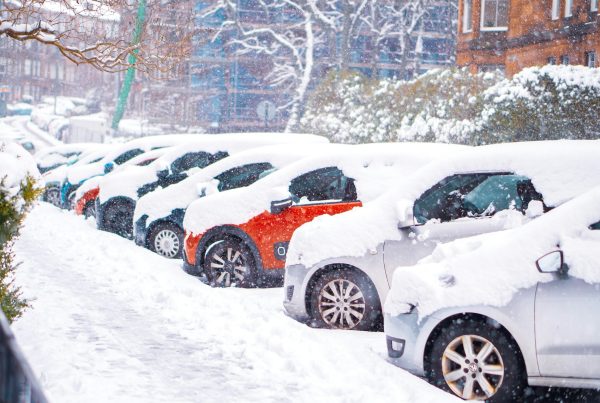Understanding the Weather Patterns That Cause Hail in Illinois
For vehicle owners in Sandwich, DeKalb County, and throughout northern Illinois, hailstorms represent one of spring’s most unpredictable threats. These destructive weather events can appear with little warning, leaving behind damaged vehicles and property. At Mike’s Tri County Collision, we’ve been repairing hail damage for over 20 years, and we’ve seen firsthand how devastating these storms can be. Understanding the weather patterns that cause hail in Illinois can help you better protect your vehicle when storm season arrives.
Why Northern Illinois Is Prone to Hailstorms
Illinois sits in a region meteorologists sometimes call “hail alley” – though not as severe as the traditional Hail Alley of Colorado, Nebraska, and Wyoming, our area still experiences significant hail activity, particularly during spring and early summer. Several factors make our region susceptible to hail-producing storms:
The Perfect Storm Conditions
For hail to form, three atmospheric conditions must exist simultaneously:
- Unstable air that encourages strong updrafts
- Moisture in the lower to mid-levels of the atmosphere
- Freezing temperatures in the upper atmosphere, even during warm seasons
Northern Illinois frequently experiences all three conditions, especially during spring when warm, humid air from the Gulf of Mexico collides with cooler, drier air from the northwest. This collision creates the instability needed for severe thunderstorms that can produce hail.
Seasonal Patterns
In our service area covering DeKalb, Kendall, and LaSalle Counties, hailstorms most commonly occur during:
- Late March through June (primary hail season)
- Early fall (September-October)
April and May typically see the highest frequency of hailstorms, which aligns with the peak of severe weather season across the Midwest. During these months, the atmospheric conditions favor the development of supercell thunderstorms – the type most likely to produce large, damaging hail.
How Hail Forms and Why Size Varies
Understanding how hail forms helps explain why some storms produce small, harmless pellets while others create golf ball-sized projectiles that can severely damage vehicles.
The Hail Formation Process
- Updrafts in thunderstorms carry raindrops upward into extremely cold areas of the atmosphere
- These raindrops freeze into ice pellets
- The pellets begin to fall but are caught by more updrafts
- Additional layers of ice form as they’re carried up and down through the cloud
- When the hailstones become too heavy for the updrafts to support, they fall to the ground
What Determines Hail Size
The strength of the updrafts largely determines the size of the hail. Stronger updrafts can keep hailstones suspended longer, allowing them to grow larger before falling. In Illinois, we typically see:
- Pea-sized hail (¼ inch): Common but causes minimal damage
- Quarter-sized hail (1 inch): Can cause significant vehicle damage, especially to hoods, roofs, and trunks
- Golf ball-sized hail (1¾ inch): Causes severe damage to vehicles, often requiring extensive repairs
- Tennis ball-sized hail or larger (2½+ inches): Rare in our area but devastating when it occurs
The National Weather Service issues severe thunderstorm warnings when hail of 1 inch (quarter-size) or larger is expected, as this is the threshold where significant property damage typically begins.
Interpreting Weather Warnings and Alerts
When severe weather approaches, understanding the terminology used in forecasts and alerts can help you take appropriate action to protect your vehicle.
Types of Alerts
- Severe Thunderstorm Watch: Conditions are favorable for the development of severe thunderstorms that may produce large hail. This typically covers a large area and lasts for several hours. When a watch is issued, it’s time to stay alert and be prepared to take action.
- Severe Thunderstorm Warning: Severe thunderstorms with hail of 1 inch or larger have been detected by radar or reported by storm spotters. This typically covers a smaller area and lasts for about 30-60 minutes. When a warning is issued for your area, take immediate action to protect yourself and your property.
- Special Weather Statements: Sometimes issued for thunderstorms that may produce hail smaller than 1 inch but could still cause minor damage.
Understanding Radar Imagery
Modern weather apps often provide radar imagery that can help you track storms. When looking at radar for potential hail:
- Purple or white colors within a storm cell often indicate the possibility of hail
- Hook echo patterns may indicate a rotating storm that has higher potential for producing large hail
- Red or pink triangles on National Weather Service radar indicate storm cells where hail has been detected
Using Weather Apps to Protect Your Vehicle
Today’s smartphone technology puts powerful weather monitoring tools in your pocket. Some of the most useful apps for tracking potential hail threats include:
Recommended Weather Apps for Predicting the Weather Patterns that Cause Hail in Illinois
- National Weather Service app or website: The official source for weather warnings and alerts
- RadarScope: Provides detailed radar imagery for tracking storm intensity and movement
- Weather Underground: Offers hyperlocal weather information from personal weather stations
- AccuWeather: Provides minute-by-minute precipitation forecasts and detailed storm tracking
Setting Up Alerts
Most weather apps allow you to set up customized alerts for severe weather. We recommend configuring alerts for:
- Severe thunderstorm watches and warnings
- Special weather statements
- Lightning detection within a certain radius of your location
- Significant changes in weather conditions
Enabling location-based alerts ensures you’ll receive notifications when severe weather is approaching your specific area, giving you time to move your vehicle to a protected location if possible.
Emergency Preparation for Sudden Severe Weather
Despite improved forecasting, hailstorms can still develop with little warning. Having a plan in place can help minimize damage to your vehicle.
Before the Storm Season
- Identify covered parking options near places you frequently visit
- Consider installing a carport or other protective structure at home
- Keep an emergency car cover in your trunk during hail season
- Check your auto insurance policy to ensure adequate coverage for hail damage
When Hail Is Imminent
If you’re driving when hail begins to fall:
- Find a covered area such as a gas station canopy, parking garage, or drive-through
- If no cover is available, pull over in a safe location away from trees
- Position your vehicle so the hail hits the front windshield, which is designed to withstand more impact than side windows
- Cover yourself with a coat or blanket to protect from potential breaking glass (rare but possible with large hail)
Local Resources for Storm Warnings and Forecasts
In DeKalb, Kendall, and LaSalle Counties, several resources provide localized weather information:
- NOAA Weather Radio: Broadcasts continuous weather information, including warnings and alerts
- Local TV and radio stations: Often provide real-time updates during severe weather
- County emergency management agencies: May offer alert systems for severe weather
- Community storm spotter networks: Provide ground-truth reports of hail and other severe weather
What to Do if Your Vehicle Sustains Hail Damage
If despite your best efforts, your vehicle sustains hail damage:
- Document the damage immediately with photos from multiple angles
- Contact your insurance company to report the claim
- Bring your vehicle to Mike’s Tri County Collision for a thorough assessment
At Mike’s, we specialize in hail damage repair and can help you navigate the entire process, from documentation to dealing with your insurance company. In many cases, we can repair hail damage using Paintless Dent Repair techniques, which preserve your vehicle’s factory finish and are typically less expensive than traditional body repair methods.
Protect Your Investment This Hail Season
Understanding the weather patterns that cause hail in Illinois is the first step in protecting your vehicle during Illinois’ unpredictable spring weather. By staying alert to weather warnings, using available technology to track storms, and having a plan for when severe weather threatens, you can significantly reduce the risk of costly hail damage.
If your vehicle does sustain hail damage, remember that Mike’s Tri County Collision has been serving Sandwich, Plano, Somonauk, DeKalb, Yorkville, Ottawa, and surrounding communities for over 20 years. Our experienced technicians can restore your vehicle to its pre-storm condition, and we’ll work directly with your insurance company to make the process as stress-free as possible.
Contact us at 815-786-2225 or email thecollisionexpert@gmail.com to schedule your free hail damage assessment.
Mike’s Tri County Collision is located in Sandwich, IL and specializes in auto body repair, collision damage repair, paintless dent repair, hail damage restoration, and insurance claims assistance. Our workmanship carries a lifetime warranty (except for rust repairs) for as long as you own your vehicle.
Contact Mike's Tri County Collision
Phone: 815-786-2225
Email: thecollisionexpert@gmail.com
Hours:
Monday 8:00am – 4:30pm
Tuesday 8:00am – 4:30pm
Wednesday 8:00am – 4:30pm
Thursday 8:00am – 4:30pm
Friday 8:00am – 4:30pm
Saturday By Appointment Only



